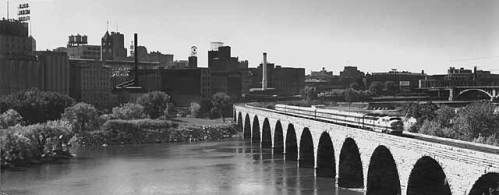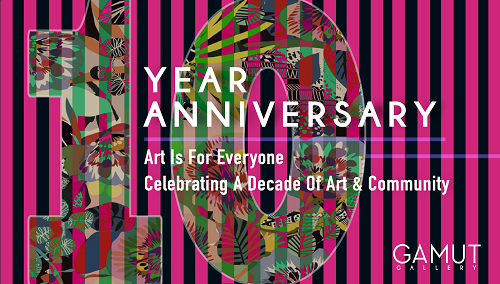Article by Becky Fillinger
 Anna BeckerArt-A-Whirl is the largest open studio tour in the country, which happens annually in sites throughout Northeast Minneapolis. The 2022 dates are this coming weekend, May 20-22, and the event includes over 60 locations and over 1,000 participating artists, galleries and businesses.
Anna BeckerArt-A-Whirl is the largest open studio tour in the country, which happens annually in sites throughout Northeast Minneapolis. The 2022 dates are this coming weekend, May 20-22, and the event includes over 60 locations and over 1,000 participating artists, galleries and businesses.
It’s a massive project to manage. We talked to Northeast Minneapolis Arts Association (NEMAA) Executive Director Anna Becker to learn some behind the scenes info and tips about this iconic weekend of art, music, demonstrations, food, beverages and fun!
Q: You’ve been involved with Art-A-Whirl for almost 10 years and performing just about every job function during that time to make it a recurring success - social media, launching a website, managing volunteers, recruiting sponsors - to your current position as Executive Director. What do you want the community to know about the work that goes into bringing Art-A-Whirl to life each year?
 A: Wow, I’m really flattered that you have been paying attention to my career within NEMAA! Yes, this will be my 10th Art-A-Whirl. Time flies.
A: Wow, I’m really flattered that you have been paying attention to my career within NEMAA! Yes, this will be my 10th Art-A-Whirl. Time flies.
It takes a massive effort to produce Art-A-Whirl. There are so many moving pieces: communications, marketing, artist and business member recruitment & management, web development, volunteers, traffic and safety, advertising sales, sponsors, fundraising, printing, distribution, admin…I could go on. Art-A-Whirl doesn’t just happen. It takes months and months of advanced planning to organize the event and make sure the platforms and information people are using to learn about and navigate it are high quality.
I think a lot of people assume that because Art-A-Whirl is huge, that NEMAA is too, when in fact we are quite tiny. This year I was able to hire another full-time employee, bringing our staff up to 2.5, with some stellar contractors that we work with for graphic design and web development. So what people are really seeing when they interact with NEMAA and Art-A-Whirl is not the efforts of a big team, but a few people taking on a variety of roles and tasks and giving it their best.
Q: Art-A-Whirl brings 45,000 visitors into Northeast Minneapolis each year, benefiting the artists of course, but also restaurants, bars and shops. Do you collaborate with local businesses to make the most of the unique opportunity?
 A: The Arts District and the greater Northeast neighborhood is an ecosystem that thrives because of the diversity of elements - the arts, the restaurants and breweries, the local shops and businesses, the parks, the homes, etc. All of these things can enrich one another if we respect each other and openly communicate.
A: The Arts District and the greater Northeast neighborhood is an ecosystem that thrives because of the diversity of elements - the arts, the restaurants and breweries, the local shops and businesses, the parks, the homes, etc. All of these things can enrich one another if we respect each other and openly communicate.
We work with neighborhood businesses to include them in Art-A-Whirl as members or sponsors, making sure they get on our maps and that their programming is included in the Art-A-Whirl Activities listings. Member restaurants and breweries are featured in our Dining and Brew Guides.
 We also have a fun program with the "I Bought Art” sticker, which NEMAA member artists give to their buyers. People wearing the sticker receive special discounts at restaurants and breweries during Art-A-Whirl weekend.
We also have a fun program with the "I Bought Art” sticker, which NEMAA member artists give to their buyers. People wearing the sticker receive special discounts at restaurants and breweries during Art-A-Whirl weekend.
Q: Do you assist artists to be better business people? If yes, how do you do it?
A: For several years NEMAA has worked with Springboard for the Arts and utilized their Work of Art workshop series to provide the Northeast arts community with information on topics ranging from marketing, photography, grant writing, and more. We’ve produced our own workshops on topics such as pricing, digital marketing, health insurance, and taxes. We also collect and publish calls for art, available space, grants, and job postings which keep our members up to date on current opportunities.
In 2020, in response to COVID shutting down an in-person Art-A-Whirl, we built a web platform that gave every NEMAA member artist and gallery the option to build an online shop. The next year we built a NEMAA Shop that also brought all those individual shops’ products into one place, so web visitors can discover new artists through their work. Lately we’ve been focused on educating the members on how to use our site to sell their work online in addition to in-person sales. We talk a lot about shipping. :)
Q: How should a first timer approach Art A Whirl?
A: Use NEMAA’s website to find an artist you like and make a plan to go visit them wherever they may be. But also, don’t drive. Use the Free Metro Transit passes NEMAA provides, or the free trolleys to get around the Arts District. Bike, walk, skate, or rideshare. Trust me on this one.
If you are not looking for anyone specifically, where you go depends on your attitude towards crowds. Do you love them? Do you get a boost from lots of people? If that’s the case, make a beeline to the nexus of buildings in the heart of the Northeast Arts District just northwest of Central Avenue & Broadway - Northrup King, Thorp, Solar Arts, Q.arma and Waterbury buildings.
 The Casket Arts Building is located at 681 17th Avenue NE Photo: Joe and Jen Photo
The Casket Arts Building is located at 681 17th Avenue NE Photo: Joe and Jen Photo
If you are looking for a lot of artists with a more relaxed vibe, get out a little farther: Casket Arts, California Building, Grain Belt, 2010 Artblok on East Hennepin. If you want something even less crowded, visit the standalone sites with small groups of artists for a more intimate experience.
Q: What is your favorite aspect of Art-A-Whirl?
A: I like talking to the artists. I send and receive a heck of a lot of emails, so I like face-to-face. My goal is eventually to be able to delegate enough of the day-of event logistics to be able to just swan around all weekend and chat with people.
 Q: I hope you get to that point, too! How may we follow your news?
Q: I hope you get to that point, too! How may we follow your news?
A: Sign up for our monthly Audience Newsletter with open studios, member events and classes.
We’re also active on Facebook, Instagram, Twitter, and soon Tik Tok. @nemaamn
 Friday, May 20, 2022 at 7:43PM |
Friday, May 20, 2022 at 7:43PM |  Kim Eslinger |
Kim Eslinger | 
 Roadway reconstruction near the Hennepin Avenue intersection.
Roadway reconstruction near the Hennepin Avenue intersection. Roadway repaving at the 1st Avenue N intersection.
Roadway repaving at the 1st Avenue N intersection.























































